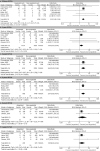A meta-analysis of safety and efficacy of endovascular aneurysm repair in aneurysm patients with severe angulated infrarenal neck
- PMID: 35202427
- PMCID: PMC8870420
- DOI: 10.1371/journal.pone.0264327
A meta-analysis of safety and efficacy of endovascular aneurysm repair in aneurysm patients with severe angulated infrarenal neck
Abstract
Objectives: A growing number of abdominal aortic aneurysms with severe angulated neck anatomy is treated by endovascular means. However, contradictory early and late outcomes have been reported. Our review and outcome analysis attempted to evaluate the available literature and provide clinicians with a base for clinical implementation and future research.
Materials and methods: A systematic review of the literature was undertaken to identify the outcomes of endovascular aneurysm repair in patients with severe infrarenal neck angulation (SNA ≥ 60°) vs non-severe neck angulation (NSNA). Outcome measures included perioperative complications, type 1a endoleak, neck-related secondary procedures, stent graft migration, aneurysm rupture, increase (>5mm) in sac diameter, all-cause and aneurysm-related mortality (PROSPERO Nr.: CRD42021233253).
Results: Six observational studies reporting on 5981 patients (1457 with SNA and 4524 with NSNA) with a weighted mean follow-up period of 1.8 years were included. EVAR in SNA compared with NSNA was associated with a higher rate of type 1a endoleak at 30 days (4.0% vs 1.8%; p< 0.00001), at 1 year (2.8% vs 1.9%; p<0.03), at 2 years (4.9% vs 2.1%; p< 0.0002), at 3 years (5.6% vs 2.6%; p< 0.0001). The rate of neck-related secondary procedures was significantly higher at 1 year (6.6% vs 3.9%; p<0.05) and at 3 years (13.1% vs 9%; p<0.05). Graft migration, aneurysm sack increase, aneurysm rupture and all-cause mortality were not statistically different at mid-term.
Conclusions: The use of EVAR in severely angulated infrarenal aortic necks is associated with a high rate of early and mid-term complications. However, aortic related and all-causes mortality are not higher compared to patients with NSNA. Therefore, EVAR should be cautiously used in patients with SNA.
Conflict of interest statement
The authors have declared that no competing interests exist.
Figures



References
-
- Karathanos C, Spanos K, Kouvelos G, Athanasoulas A, Koutsias S, Matsagkas M, et al.. Hostility of proximal aortic neck anatomy in relation to abdominal aortic aneurysm size and its impact on the outcome of endovascular repair with the new generation endografts. J Cardiovasc Surg (Torino). 2020. Feb;61(1):60–66. doi: 10.23736/S0021-9509.18.10001-2 Epub 2018 Jan 9. . - DOI - PubMed
-
- Jordan WD Jr, Mehta M, Varnagy D, Moore WM Jr, Arko FR, Joye J, et al.. Aneurysm Treatment using the Heli-FX Aortic Securement System Global Registry (ANCHOR) Workgroup Members. Results of the ANCHOR prospective, multicenter registry of EndoAnchors for type Ia endoleaks and endograft migration in patients with challenging anatomy. J Vasc Surg. 2014. Oct;60(4):885–92.e2. doi: 10.1016/j.jvs.2014.04.063 Epub 2014 Jul 31. . - DOI - PubMed
Publication types
MeSH terms
LinkOut - more resources
Full Text Sources
Research Materials

